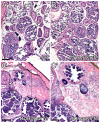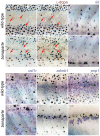Basonuclin-2 requirements for zebrafish adult pigment pattern development and female fertility
- PMID: 19956727
- PMCID: PMC2776513
- DOI: 10.1371/journal.pgen.1000744
Basonuclin-2 requirements for zebrafish adult pigment pattern development and female fertility
Abstract
Relatively little is known about the generation of adult form. One complex adult trait that is particularly amenable to genetic and experimental analysis is the zebrafish pigment pattern, which undergoes extensive remodeling during post-embryonic development to form adult stripes. These stripes result from the arrangement of three classes of neural crest-derived pigment cells, or chromatophores: melanophores, xanthophores, and iridophores. Here, we analyze the zebrafish bonaparte mutant, which has a normal early pigment pattern but exhibits a severe disruption to the adult stripe pattern. We show that the bonaparte mutant phenotype arises from mutations in basonuclin-2 (bnc2), encoding a highly conserved, nuclear-localized zinc finger protein of unknown function. We show that bnc2 acts non-autonomously to the melanophore lineage and is expressed by hypodermal cells adjacent to chromatophores during adult pigment pattern formation. In bonaparte (bnc2) mutants, all three types of chromatophores differentiate but then are lost by extrusion through the skin. We further show that while bnc2 promotes the development of two genetically distinct populations of melanophores in the body stripes, chromatophores of the fins and scales remain unaffected in bonaparte mutants, though a requirement of fin chromatophores for bnc2 is revealed in the absence of kit and colony stimulating factor-1 receptor activity. Finally, we find that bonaparte (bnc2) mutants exhibit dysmorphic ovaries correlating with infertility and bnc2 is expressed in somatic ovarian cells, whereas the related gene, bnc1, is expressed within oocytes; and we find that both bnc2 and bnc1 are expressed abundantly within the central nervous system. These findings identify bnc2 as an important mediator of adult pigment pattern formation and identify bonaparte mutants as an animal model for dissecting bnc2 functions.
Conflict of interest statement
The authors have declared that no competing interests exist.
Figures









References
Publication types
MeSH terms
Substances
Grants and funding
LinkOut - more resources
Full Text Sources
Molecular Biology Databases
Research Materials

